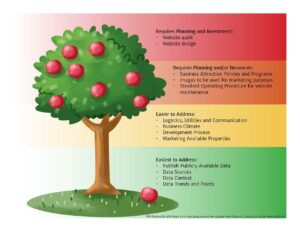Working in economic development in small towns and rural areas takes passion. It requires vision that sees beyond “what was” into “what is” to create the energy around “what could be” – through flexible planning, implementable tactics, extreme patience and tenacious passion for what makes each community interesting and meaningful.
Increasingly, the “Assets” key to an asset-based approach to economic and community development – the foundation of any plausible development strategy – are shifting. Often, traditional area jobs and industries have migrated out of an area, forcing a re-evaluation of what makes the community economically relevant.
Lyn Falk, Founder of Retailworks, Inc. and Partner with Redevelopment Resources recently shared an article authored by Becky McCray which is based on her work in, and results from, a study recently released by the Regional Economic Development for Eastern Idaho (REDI) as well as her Survey of Rural Challenges. The article and information not only ring of a passion that the Redevelopment Resources team shares, but also succeed in filtering truths from perceptions on rural community challenges.
Rural folk know, as her article states, the quintessential rural challenge is understanding what is important to young rural talent. Adeptly, McCray applies this work toward battling perceptions of rural challenges as well: that, despite what might be inferred from the headlines, rural folks are much less concerned about “jobs” as they are about “talent”. Of course, each of these works build on the other – one must understand what is important to rural talent if you want to attract and retain it.
The making of a Place
A couple of years ago, Redevelopment Resources had the pleasure of facilitating an event centered around a Place-making webinar made available through the IEDC. Researchers had delved into the art of developing a sense of place in an effort to increase a community’s “stickiness” to young talent, particularly those new to an area. Two of the leading factors in a community’s success in retaining talent went hand-in-hand: its “Openness” (read: willingness to welcome any and all into the fold), and the ability of the newcomer to have a social “in” (read: valuable way to contribute to the community).
Increasingly, new residents and young people – who have ready access to being heard 24/7 on social media – want to have their voices heard in their communities. This is a good thing. However, as pointed out in McCray’s work, and witnessed by community consultants across the U.S. – while communities are “asking” millennials what their perceptions are, they are very rarely willing to hear the answer. An excerpt from the in-article list of “Practical Steps for Smaller Rural Towns to Retain Millennials” (emphasis mine):
1. Listen to your millennials.
There are already young people choosing to live in your community. Ask them why they’re here and listen deeply to their answers. Don’t interrupt. I can’t tell you how many times I’ve watched older community members ask what younger people want, then interrupt their answers to tell them how wrong they are. Especially when a young person offers a comment about how little there is to do, older people rush in with interruptions about all the great things the young people are overlooking. Don’t do this. When you ask for their insight, take the time and be respectful enough to actually listen without interrupting. Focus on writing down what they are saying instead of responding.
It is the nature of societal evolution to have younger and older generations at odds; however, this gap does nothing to serve the goals of the community. Millennials have been shown to be more civic-minded and socially conscious than their predecessors; it behooves communities to invite them to the table and engage in their recommendations and feedback. It is more likely that a millennial will be willing to commit time, energy and passion to the community cause than previous generations – embrace this.
But they don’t show up!
Millennials and the following generation do not engage in an analog manner unless it will be a valuable experience. Rather than being quieted during a public meeting, they would rather reach out to their 300+ followers on social media about their perceptions on the challenges of the day. The youth are showing up in the relevant public spaces on 2017. It is community leadership that is often “not showing up” in these spheres. By not engaging the next generation where they are (on social media), you are assuring that they will not engage where you are (in a structured public meeting). As McCray states in her online video:
“The time where a small group of people can sit in a room and run your town is over. The time where…regular people will shape your town by every decision [they] make, everyday, is right now.”
But the nay-sayers camp out and make it a nightmare!
Social media spaces are difficult, but rest assured, whether you are engaged in it or not, the Conversation is Always On. Staying on top of the message — and being proactive about it through services like POLCO are great ways to get measurable feedback that filters the noise and gains results.
Retail down, Industrial up.
The headline assumes, of course, that Retail is actually “down.” While overall square footage of active retail space has declined in the US (with more closures of big-box retailers in 2017 than in 2008) overall retail spending has been on the rise since April 2009. While doom seems looming for the retail sector given the onslaught of closures and bankruptcies, the more likely explanation is that, just like other markets, there is a correction happening in retail.
The US retail sector has been grossly over-built, hosting 6 times the square footage per capita devoted to brick and mortar shopping than our European and Japanese counterparts.
As stated by Jason Mudrick, CIO of Mudrick Capital Management, in an interview with Bloomberg, when it comes to retail closures:
“This is not a cyclical issue. The economy has been good…consumer sentiment is up…this is a secular issue – this is a ‘forever’ trend.”
So, yes. Retail square footage down, Industrial (warehousing / logistics) up.
A recent blogspot by Daniel French, the Founder and CEO of Brownfield Listings cited an interesting estimate by CBRE: For every $1 billion in E-Commerce sales, 1.2 Million square feet of logistics space is absorbed in the market. Overall, CBRE market studies indicate that the warehousing development pipeline has hit an all-time high in Q1 2017.
What does this mean for communities?
First and foremost, understanding consumer trends that fed the retail onslaught, and most importantly, how those trends no longer apply to today’s market, will be the biggest challenge. A quick primer can be found here in an article in The Atlantic by Derek Thompson. I would, however like to tweak the presentation of his points – specifically, the order that the contributing factors are presented.
While it is easy to simply present as the leading factor that more sales are happening online, the more important factor is that which has been listed last: the lifestyle of today’s consumer is no longer congruent with the consumerist approach that fueled retail’s rise. It is almost as if the next generation actually listened when a slew of “self-help” authors encouraged America to seek social connection, take it slow and savor experiences – because the social fixations have mirrored those calls: shifts from fast cars to slow food; seeking experiences over material goods; serving social causes while seeking profits. As a result, we see the rise of travel dollars, restaurant spending, and a nomadic nature of the high income, long term renter class.
If these shifts are internalized by the communities that are home to these retail vacancies, transitions toward value-added experiences, education, and supportive services in vacant retail spaces may be expedited, minimizing the impact of the loss.
An important caveat: as stated during Murdick’s Bloomberg interview above (as well as by others), Class A mall spaces remain relevant. Proactive surveying of the landscape for communities with B and C space, and working with retailers and investors on “whats next” to maintain relevance for that square footage is already critical.
If your community is in need of a strategy on how to approach this systemic economic challenge, give Redevelopment Resources a call. We delight in developing creative solutions for local markets. www.redevelopment-resources.com






